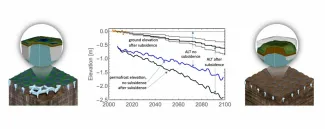Ground Subsidence in Arctic Tundra Unlikely to Trigger Abrupt Thaw
Drying of tundra landscapes will limit subsidence-induced acceleration of permafrost thaw.
Researchers extended a permafrost thermal hydrology model to represent uneven sinking of the ground surface caused by soil ice deposits melting. Uneven sinking has been observed to accelerate permafrost thaw over small areas, but models were unable to evaluate potential impacts over larger scales. In this study, spatially resolved simulations focused on tundra containing wedge-shaped deposits of ice, a common type of landscape in the Arctic. Cryohydrology simulations were informed by data from a representative site. Results suggest that subsidence-induced acceleration of permafrost thaw will be self-limiting on decadal time scales.
The study sought to understand consequences of a potential positive feedback loop between uneven subsidence and permafrost thaw, which could trigger abrupt and large-scale change in the Arctic. Researchers extended the Advanced Terrestrial Simulator, a site-scale permafrost thermal hydrology model, to represent uneven ground subsidence in polygonal tundra, carbon-rich regions of the Arctic where soils are honeycombed by wedges of ice that express in polygonal patterns. Existing data and new measurements of ground ice content informed simulations of a small catchment near Utqiaġvik, Alaska. Simulations agreed well with multiple types of observations.
Projections indicate 63 cm of bulk subsidence from 2006 to 2100 in the strong-warming Representative Concentration Pathway 8.5 climate. Permafrost thaw as measured by the increase in active layer thickness (ALT)—the thickness of the soil layer that thaws each summer—is accelerated by subsidence, but the effect is relatively small. ALT increases from the current-day value of approximately 50 cm to 180 cm by 2100 when subsidence is included compared to 160 cm when it is neglected. The effect on thaw-exposed soil carbon is larger. Specifically, the mass of soil solids thawing each summer increases by approximately 65% by subsidence. Subsidence also increases runoff efficiency, which will help maintain streamflow but lead to significantly drier tundra conditions. Although uneven subsidence is unlikely to trigger abrupt thaw over large areas, the effects on landscape hydrology and tundra carbon stocks may be significant and should be included in Earth system models.
This study addressed one of the biggest uncertainties about how carbon-rich regions of the Arctic will respond to warming temperatures: the potential for uneven ground subsidence to accelerate permafrost thaw in a positive feedback loop. Simulation results for a tundra site that represents large swathes of the Alaska North Slope suggest that landscape drying will limit the effect of subsidence and prevent abrupt thaw over large areas. However, subsidence increases landscape runoff, which helps maintain streamflow in the face of increased evapotranspiration but causes drier tundra conditions that could have deleterious effects on sensitive Arctic wetland ecosystems.
Projections of permafrost thaw and thermokarst development for a polygonal tundra site near Utqiaġvik, Alaska. The middle panel shows projected ground and permafrost elevation with (black) and without (blue) subsidence. Three projected ground elevations are shown, corresponding to the median (black) and the 20th and 80th percentiles (gray) of the excess ice distribution. The reference case using the median ice content is in good agreement with the observed and published subsidence rates (orange dots). The single-polygon geometric models shown on the left (early 21st century) and right (2100) were constructed by postprocessing results to illustrate the evolution from poorly drained low-centered polygons to high-centered polygons with well-defined troughs.
Painter, S. L., et al. "Drying of Tundra Landscapes Will Limit Subsidence-Induced Acceleration of Permafrost Thaw." Proceedings of the National Academy of Sciences 120 (8), e2212171120 (2023). https://doi.org/10.1073/pnas.2212171120.
This research was supported by the Director, Office of Science, Office of Biological and Environmental Research of the US Department of Energy under Contract No. DE-AC02-05CH11231 as part of the Next-Generation Ecosystem Experiments (NGEE Arctic) project.
For more information, please contact:
Scott Painter
paintersl@ornl.gov

